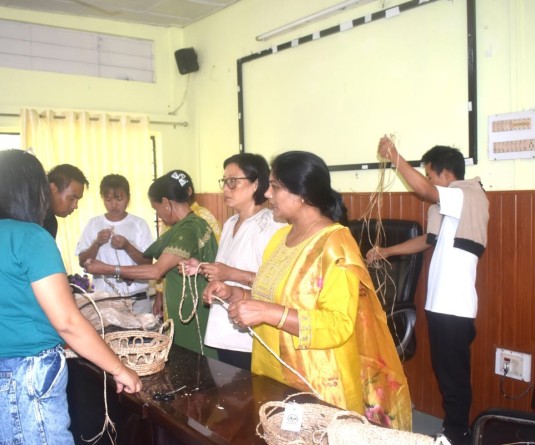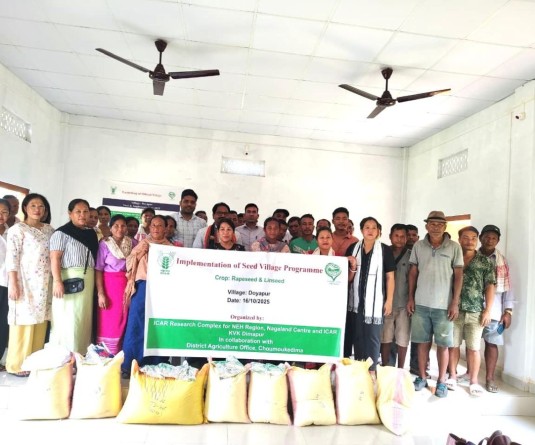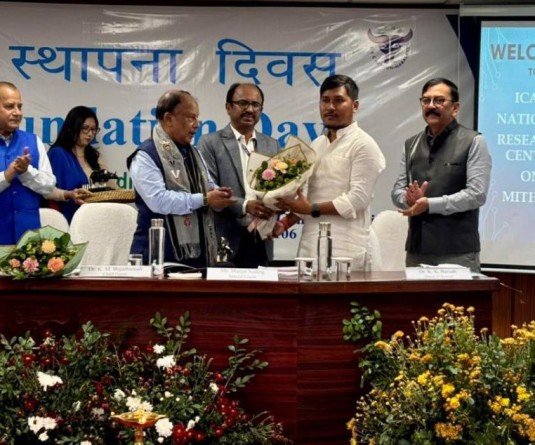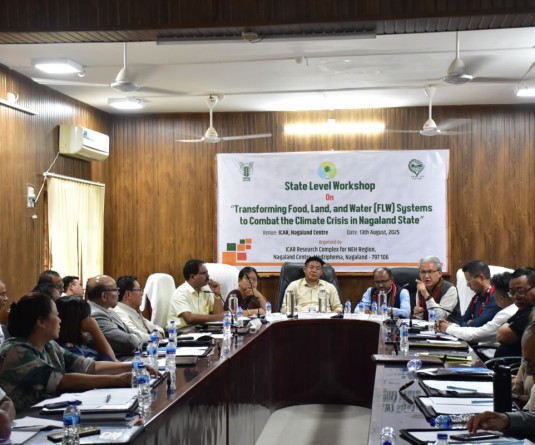
Introduction: Naga King Chilli belongs to genus Capsicum of family Solanaceae. It is popularly known as Raja Mircha or the ‘king chilli’ which is considered the world’s hottest chilli. It features among the hottest five chillies on the Scoville Heat Units (SHUs) list. The Naga Mircha was certified as Geographically Indications (GI) tagged to Nagaland in 2008. King Chilli is grown in almost all the district of Nagaland. Peren district share 52.60 percent of cultivated area (282 ha) out of 595 ha area in Nagaland with a production of 1696 metric tonnes and productivity of 6.01 t/ha as compared to State average productivity of 4.47 t/ha with a production of 2659.80 metric tonnes.
Information on Naga King Chilli Cultivation scenario
Sl. No. | Particulars | Peren District | Nagaland State |
1. | Area (ha) | 282 | 595.00 |
2. | Percentage share of Area | 52.60 | - |
3. | Production (Metric Tonnes) | 1696.00 | 2659.80
|
4. | Percentage share of Production | 36.23 | - |
5. | Productivity (Metric Tonnes) | 6.01 | 4.47 |
Source: Nagaland Statistical Handbook - 2021
2. Present Marketing situation of Naga King Chilli:
Marketing of King Chilli involved several challenges. There is limited accessibility to market information, low in literacy level among the farmers, multiple channels of distribution that reduced the pockets of both farmers and consumers. Funding of farmers by the government is still at infant stage and most of the small farmers depend on the local money lenders who siphon away the hard earned money through charging high interest rate. There are several loopholes in the present legislation and there is no organised and regulated marketing system for marketing King Chilli in the district. The farmers are facing so many hardships to get fair price for their produce.
Present marketing channel of king chilli in Peren district:
- Producer - Consumer (Village/Daily/Weekly Market)
- Producer – Retailer – Consumer (Daily/Weekly Market)
- Producer - Middleman - Consumer (Daily/Weekly market)
- Producer - Middleman - Retailer - Consumer (Daily/Weekly market)
- Producer – Middleman – Wholesalers – Consumer (Dimapur/Kohima wholesale market)
- Producer – Middleman – Wholesaler – Retailer – Consumer (Dimapur/Kohima wholesale market)
- Producer – Middleman – Processing unit (Within the state and Neighbouring states)
- Producer – Online exporters.
3. SWOT Analysis of King Chilli cultivation in Peren district:
Strength | Weakness |
• Favourable agro climatic condition and was certified as Geographically Indications (GI) tagged to Nagaland in 2008. • Knowledge of traditional agricultural practices. • Fertile soil. • Less use of agro-chemicals. • Varied ecological zone.
| • Fragmented cultivated area. • Mostly hilly terrain area. • Mostly poor marginal farmers. • Non availability of quality seed. • Lack of improve tools, implements and equipments. • Lack of irrigation and mechanized facilities. • Low adoption to modern technologies. • Highly perishable. • Poor road connectivity. • High cost of transportations. • Less number of Agro-input outlets. • Limited banking facilities for financial assistance. • No Agriculture Markets and Cold storage. |
Opportunity | Threat |
• Scope for expansion of cultivated area. • Scope for round the year cultivation. • Scope for protected cultivation. • Scope for increasing production and productivity. • Scope for mix cropping with other agricultural and horticultural crops. • Scope for post harvest management and value added products. • Scope for development of regulated Agri –Market. • Near to Railway station and Airport • High scope for organic cultivation. • Scope for international export. | • Over exploitation from middle man due to unregulated agriculture marketing system. • Decline in production and productivity due to various factors viz., Decline in soil fertility due to soil erosion, lack of scientific cultivation practices, Pest and Diseases, Lack of interest due to less profit. • Shifting of rural youth from agriculture sector to other non agricultural sector.
|
4. Suggestions for improvement in Agriculture sector:
Strategies | Agriculture | Implementing department |
Short-term | Awareness and demonstration of low cost and farmer friendly technologies. Use of HYV, IPM, IDM, INM, Usage of farm machineries, Area expansion through double cropping system, Soil and water conservation measures | KVK, ATMA, ICAR, State Agriculture Dept, Soil and water conservation, Land Resources Dept and NGOs. |
Medium-term | Crop diversification and intensification, Providing Irrigation facilities, Post harvest management, Formation of crop specific SHG and FPO. | KVK, ICAR, State agriculture Dept, Soil and water conservation, Land Resources Dept, Dept of water resources. |
Long-term | Improving linkages among stake holders, Custom hiring centres, Establishment of oilseeds and pulses based food processing unit Development of market hub. | KVK, ICAR, State agriculture Dept Soil and water conservation, Land Resources Dept |
5. Suggestions for improvement in Horticulture sector:
Strategies | Horticulture | Implementing department |
Short-term | Arrangement for collecting planting materials and improved varieties of vegetable seeds from authentic sources, Usage of resistant varieties, Bio-control measures, IPM,IDM,INM, Usage of farm machineries, Area expansion through IFS and agroforestry, Demonstration of identified technologies in farmers field, Capacity building of officers, field level functionaries and farmers, Replacement with HYV. | KVK, ATMA, ICAR, State Horticulture Department, CIH Bio-control lab, Land Resources Department. |
Medium-term | Establishment of nurseries, poly house, hi-tech polyhouse, Nursery management. Value-addition, Reduction in post harvest losses, Area expansion, Creation of in-situ water harvesting for life saving irrigation, Seed production of breeders and certified seeds may be taken up in phase manner. | KVK, ICAR, State Horticulture Department, CIH, Land Resources Department. |
Long-term | Establishment of small scale processing units, Establishment of market with modern amenities, Establishment of plant tissue culture laboratory. | KVK, ICAR, State Horticulture Department, CIH, Land Resources Department. |
6. Measures for helping the farmers:
Some measures that can be taken to help the farmers include,
- To provide loans to the farmers at low rate of interest to avoid squeezing them from local money lenders.
- To create a new distribution network that connects the farmers directly to the consumers to get maximum returns.
- There should be strict action against black marketers and hoarders.
- Creating local outlets at each village where the farmers sell their produce directly to the consumer or authorized dealers.
- Existing legislations need to be updated with the changing trends and technological innovations.
- Government should levy single entry tax instead of levying multiple entry taxes for the transportation and activities related to agriculture and animal sector.
References:
1. Nagaland Statistical Handbook - 2021
2. Organic production practices of King chilly, Folder, KVK Dimapur
3. Debojit Konwar (2021) Naga king chilly cultivation in Nagaland: its prospect and challenges: a descriptive study. Emperor Journal of Economics and social science research. DOI:10.35338/EJESSR.2021.3511
Article contributed by Z James Kikon, Patu K Zeliang, KL Meena, L Babita Devi; Krishi Vigyan Kendra Peren, ICAR Research Complex for NEH Region, Peren, Nagaland.






